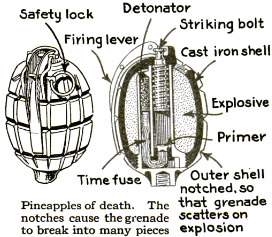How the Deadly Mills Hand Grenade Is Made and Exploded
Item
-
Title (Dublin Core)
-
How the Deadly Mills Hand Grenade Is Made and Exploded
-
Article Title and/or Image Caption (Dublin Core)
-
How the Deadly Mills Hand Grenade Is Made and Exploded
-
Caption: Pineapples of death. The notches causes the grenade to break into many pieces
-
extracted text (Extract Text)
-
THE grenades
which are used
by the French and
allied troops at the
West front are of
the type invented
by William Mills,
an Englishman.
The grenades of
the Mills type are
egg-shaped, about
four inches long and
nearly three inches
in diameter. The
outside shell is of
cast iron and deeply
notched. The fuse
and the ignition device are enclosed in a
separate tube which is inserted into the
outer shell and secured by a screw thread
at one end. .
The inner core consists of two parallel
tubes connected by a U. In the wider of
the two tubes is a plunger or striking
bolt surrounded by a spiral spring which
has the tendency to press the bolt against
the ignition cap. The bolt is drawn away
from the cap by overcoming the pressure
of the spring and is held back by a trigger
or firing lever locked securely by a pin
to which a ring is attached. When the
grenade is to be used, the locking pin
holding the firing lever is pulled out, and
the man clasps his hand around the shell,
to prevent the lever from moving. When
the grenade is thrown, the firing lever
under pressure of the spring around the
striking bolt flies up, releasing the bolt,
which is flung down upon the ignition
cap by the action of the spring. ‘The
cap explodes and ignites the time fuse,
a slow-burning powder, which com-
municates with the detonator in the
upper end of the narrower part of the U.
The detonator
causes the lyddite
or other powerful
explosive with which
thegrenadeisloaded,
to explode. The gre-
nades now used by
our allies may differ
in small details, but
the main features are
alikeinall. Thereisa
good reason for the
deep notching of the
outershell. Itisthat
when exploded the
grenade may break
into many pieces.
-
Language (Dublin Core)
-
eng
-
Date Issued (Dublin Core)
-
1918-08
-
pages (Bibliographic Ontology)
-
218
-
Rights (Dublin Core)
-
Public Domain (Google digitized)
-
Archived by (Dublin Core)
-
Filippo Valle
-
Alberto Bordignon (Supervisor)
 Popular Science Monthly, v. 93, n. 2, 1918
Popular Science Monthly, v. 93, n. 2, 1918



